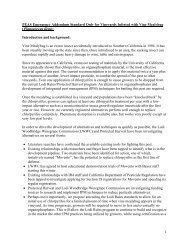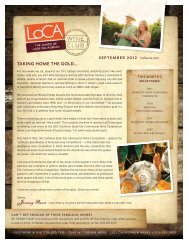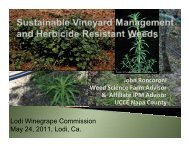Code of Sustainable Winegrowing Practices Project - Lodi Wine
Code of Sustainable Winegrowing Practices Project - Lodi Wine
Code of Sustainable Winegrowing Practices Project - Lodi Wine
Create successful ePaper yourself
Turn your PDF publications into a flip-book with our unique Google optimized e-Paper software.
Vineyard Views<br />
By Cliff Ohmart 1<br />
On September 17, 2002 an important event for the California <strong>Wine</strong> Industry will<br />
take place. A press conference is being held in San Francisco to launch The <strong>Code</strong> <strong>of</strong><br />
<strong>Sustainable</strong> <strong><strong>Wine</strong>growing</strong> Workbook, a voluntary self-assessment workbook for the <strong>Code</strong><br />
<strong>of</strong> <strong>Sustainable</strong> <strong><strong>Wine</strong>growing</strong> <strong>Practices</strong> <strong>Project</strong> (SWP). The SWP is a project <strong>of</strong> the <strong>Wine</strong><br />
Institute (WI), a statewide vintner organization, and California Association <strong>of</strong> <strong>Wine</strong>grape<br />
Growers (CAWG), a statewide grower organization. In the next few paragraphs I will<br />
describe the history <strong>of</strong> the SWP project, its goals, and the purpose <strong>of</strong> the self-assessment<br />
workbook.<br />
History <strong>of</strong> the SWP <strong>Project</strong><br />
The California winegrowing community with a 150-year-old wine industry is<br />
committed to social responsibility and cultivating and producing world-class wines. The<br />
industry recognizes the importance <strong>of</strong> the environment in and around vineyards and<br />
wineries, respects their neighbors, and makes positive social and economic contributions.<br />
Therefore the winegrowing community has come together to establish voluntary high<br />
standards <strong>of</strong> sustainable practices by the entire wine community. The SWP program will<br />
promote winegrowing and winemaking practices that are compatible with the<br />
environment, responsive to the needs and interests <strong>of</strong> society-at-large, and are<br />
economically feasible in practice.<br />
As California’s population grows, land will become an increasingly precious<br />
commodity. The winegrowing community will demonstrate and communicate that they<br />
are stewards <strong>of</strong> the land and strive to sustain their industry for generations to come.<br />
Furthermore, the California wine community intends to create a win-win environment for<br />
everyone by embracing progressive attitudes and raising cultural and community<br />
awareness and maintaining California’s standing as a world-class competitor in the global<br />
wine marketplace.<br />
The SWP project builds on the impressive work in sustainable practices by many<br />
regional winegrowing and vintner associations, private companies, individual<br />
viticulturists and winemakers, university researchers, government agencies and<br />
innovative regulators involved in the California wine community. Two groups, in<br />
particular, provided inspiration for the project, the <strong>Lodi</strong>-Woodbridge <strong>Wine</strong>grape<br />
Commission (LWWC) and the Central Coast Vineyard Team (CCVT). The CCVT were<br />
pioneers in developing the first vineyard self-assessment, the Positive Point System 2 .<br />
Subsequently, LWWC combined elements <strong>of</strong> the Positive Point System, new<br />
winegrowing content, and a four-category self-assessment format developed by<br />
Farm*A*Syst 3 to produce the <strong>Lodi</strong> <strong>Wine</strong>grower's Workbook: A self-assessment <strong>of</strong><br />
integrated farming practices.<br />
1 Sources for the SWP project description are The <strong>Code</strong> <strong>of</strong> <strong>Sustainable</strong> <strong><strong>Wine</strong>growing</strong> Workbook and<br />
www.wineinsitute.org/communications/<strong>Sustainable</strong>Pracitces/vision.htm<br />
2 Information about the Central Coast Vineyard Team and the Positive Point System can be found at<br />
http://www.vineyardteam.org.<br />
3 Information about Farm*A*Syst can be found at http://www.wisc.edu/farmasyst/<br />
1
Overall leadership and guidance for the SWP project is provided by a committee<br />
between the WI and CAWG known as the <strong>Sustainable</strong> <strong><strong>Wine</strong>growing</strong> Joint Committee.<br />
This committee includes more than 50 members from the <strong>Wine</strong> Institute and CAWG,<br />
along with representatives from the California Environmental Protection Agency and<br />
independent consultants. The Joint Committee contracted with RealToolbox, a<br />
sustainable agriculture and resource conservation pr<strong>of</strong>essional services firm, to direct the<br />
SWP project.<br />
<strong>Project</strong> Goals and Workbook Description<br />
The overall purpose for the <strong>Code</strong> <strong>of</strong> <strong>Sustainable</strong> <strong><strong>Wine</strong>growing</strong> <strong>Practices</strong> project includes:<br />
! Establishing voluntary high standards <strong>of</strong> sustainable practices to be followed and<br />
maintained by the entire wine community;<br />
! Enhancing winegrower-to-winegrower and vintner-to-vintner education on the<br />
importance <strong>of</strong> sustainable practices and how self-governing will enhance the<br />
economic viability and future <strong>of</strong> the wine community; and<br />
! Demonstrating how working closely with neighbors, communities and other<br />
stakeholders to maintain an open dialogue can address concerns, enhance mutual<br />
respect, and accelerate results.<br />
The principal purpose <strong>of</strong> the SWP workbook is to provide winegrowers and vintners with<br />
a tool to voluntarily:<br />
! Assess the sustainability <strong>of</strong> current practices;<br />
! Identify areas <strong>of</strong> excellence and areas where improvements can be made; and<br />
! Develop action plans to increase an operation’s sustainability.<br />
It is important to note that the SWP workbook is a voluntary self-assessment tool.<br />
The workbook is not a “how to” manual for winegrowing and winemaking, a set <strong>of</strong><br />
“rules” that must be followed, or an external rating system to be used by others to judge<br />
one’s vineyard or winery operation.<br />
The primary audience for the SWP workbook is California winegrowers and<br />
vintners. It is intended that the workbook content also be useful to a wider audience<br />
inside and outside California, including employees, suppliers, winegrape and wine<br />
buyers, neighbors and local community members, members <strong>of</strong> the environmental and<br />
social equity communities, policy makers, regulators, media and consumers.<br />
The first five chapters <strong>of</strong> this self-assessment workbook (Viticulture, Soil<br />
Management, Water Management, Pest Management, and <strong>Wine</strong> Quality) have been<br />
directly adapted from LWWC’s <strong>Lodi</strong> <strong>Wine</strong>grower's Workbook. The remaining eight<br />
chapters (Ecosystems Management, Energy Efficiency, <strong>Wine</strong>ry Water Conservation and<br />
Quality, Material Handling, Solid Waste Reduction and Management, Environmentally<br />
Preferred Purchasing, Human Resources, and Neighbors and Communities) were<br />
developed for this project by gathering input from the <strong>Sustainable</strong> <strong><strong>Wine</strong>growing</strong> Joint<br />
Committee, conducting an extensive literature review, and drawing upon the expertise <strong>of</strong><br />
the RealToolbox consulting team. Particularly useful sources <strong>of</strong> information on<br />
sustainable winery operations included the Sonoma County Green Business Program 4 ,<br />
4 For more information see http://www.sonoma-county.org/eservice/Cklist.htm.<br />
2
<strong>Wine</strong>ry Eco-Efficiency Assessment Guide, and the California EPA's Environmental<br />
Management Systems pilot project 5 on wineries.<br />
SWP <strong>Project</strong> Implementation<br />
Although putting the SWP workbook together was a prodigious task, getting it<br />
into the hands <strong>of</strong> winegrape growers and vintners and having the workbook put to use in<br />
the vineyard and winery is even more challenging. There are several reasons for this.<br />
One <strong>of</strong> the biggest is best described as fear <strong>of</strong> the unknown on the part <strong>of</strong> some growers<br />
and vintners. Growing winegrapes and making wine is a very expensive and risky<br />
business. Anything that comes along that suggests changing the way some things are<br />
done is understandably a scary proposition. Another reason is that everyone is already<br />
too busy and asking a vintner or grower to take time to evaluate their winery or vineyard<br />
using the SWP workbook is asking a lot. The last reason I will mention is the ‘I have<br />
been doing this for years and you can’t tell me how to do it any better’ syndrome. We all<br />
are proud <strong>of</strong> what we do and feel like we are doing a good job at it, otherwise we would<br />
have changed the way we do things already. When someone comes along and suggests a<br />
different way to do things it is sometimes hard to accept. However, because the SWP<br />
workbook was developed with the help <strong>of</strong> vintners and growers when the user gets past<br />
the resistance reactions they will most likely discover a document that will help them in<br />
many ways.<br />
The SWP project implementation will benefit from previous experience <strong>of</strong> similar<br />
programs. For example, LWWC staff have implemented the <strong>Lodi</strong> <strong>Wine</strong>grower’s<br />
Workbook program by convening small workshops <strong>of</strong> 5-10 growers at a time, sitting<br />
down with the growers and helping them go through the entire workbook evaluating one<br />
<strong>of</strong> their vineyards. Usually a grower will invite several neighbors over to their house and<br />
the workbook workshop will be held there. Over the last 2 years LWWC has convened<br />
37 workshops attended by 254 growers and these growers farm about two thirds <strong>of</strong> the<br />
acres in the district (> 56,000 acres). This experience demonstrates that, in time a large<br />
number <strong>of</strong> growers can be introduced to self-assessment.<br />
An intense implementation program as described above is not cheap. Therefore<br />
WI and CAWG have formed a joint non-pr<strong>of</strong>it organization, (name here), whose mission<br />
is to raise money for SWP project implementation and oversee its execution.<br />
Why is the SWP <strong>Project</strong> Important<br />
Agriculture is a conservative industry and for good reason. It is an expensive,<br />
risky business and a change in the wrong direction can mean financial ruin. As a result<br />
agriculture historically has been resistant to change. When something new comes along,<br />
such as regulatory issues that require change, the general attitude is to resist the change<br />
and hope the issues will go away. However, many <strong>of</strong> the sustainability issues confronting<br />
winegrape growers are not going to go away and the industry, in general, has recognized<br />
this fact. The SWP project demonstrates to people inside and outside the industry the<br />
desire <strong>of</strong> vintners and growers to be proactive in the face <strong>of</strong> these challenging issues.<br />
<strong>Sustainable</strong> farming is difficult to define and not well understood by a significant<br />
portion <strong>of</strong> the agricultural community. Ask 10 people for a definition and you are likely<br />
to get 10 different answers. This lack <strong>of</strong> understanding was graphically brought to my<br />
5 For more information see http://www.calepa.ca.gov/EMS/Publications/pilots/wine0600.htm<br />
3
attention recently when one grower said they were not interested in the SWP project<br />
because they were already ‘way past sustainability’ in their vineyard operations. The<br />
reason sustainable farming is difficult to define is that it is very complicated and we are<br />
stilling learning about it. The SWP workbook helps vintners and growers define<br />
sustainability in very specific terms relative to their own operations. Moreover, it helps<br />
them measure their current level <strong>of</strong> sustainability and if used over time will help them<br />
track their improvement. Improvement is the key word because sustainable farming is<br />
about continual improvement.<br />
I will end with mentioning what I think is the most important aspect <strong>of</strong> the SWP<br />
workbook. It helps the grower and vintner identify where they have problems and then<br />
develop action plans to deal with these problems. No matter how good <strong>of</strong> a farmer or<br />
winemaker someone is there is always something that can be improved upon. Whether<br />
we want to admit it or not, we all have problems on our farms or in our wineries. The<br />
SWP workbook helps identify those problems in very constructive ways and then can be<br />
used to develop actions plans to deal with them.<br />
Someone might say I cannot afford to be sustainable in all aspects <strong>of</strong> my<br />
operation, I say as an industry we can’t afford not to be.<br />
4









